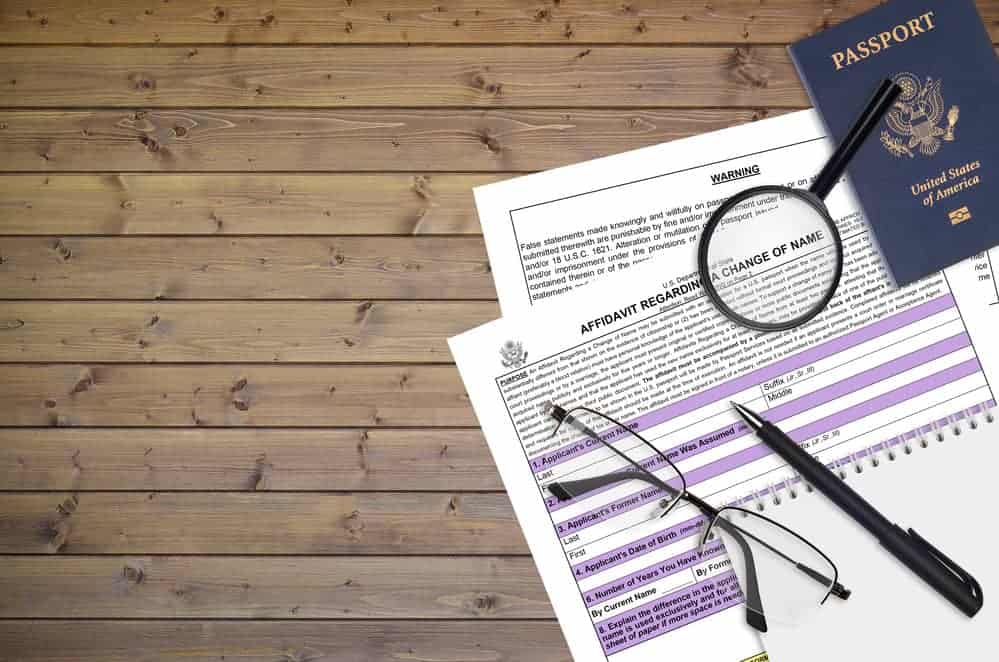Many wonder if changing their last name without getting married is possible. The process of changing one’s last name may seem like a daunting task, but it is not limited to only those who are tying the knot. Various reasons motivate people to make this change, such as personal, professional, or even to honor a specific person or cultural heritage. This article will explore the topic and guide those considering changing their last name without marriage.
It is worth noting that changing one’s last name without marriage differs from country to country, even within different states or provinces. It is essential to research and understand the legal requirements and procedures involved in your specific jurisdiction. Often, a legal name change will require filing a petition or application with the relevant government authorities, and the process can vary in complexity, cost, and duration.
Further, some jurisdictions might have specific reasons that warrant a name change, such as escaping domestic violence or restoring a family’s original name. In these cases, an individual may need to provide documented evidence or affidavits supporting their request for a name change. Gathering all the necessary information and following any legal requirements is crucial to ensure a successful and smooth name change process without getting married.
Reasons for Changing your Last Name
Divorce
One of the main reasons people change their last names is after a divorce. People who changed their surname when they married may want to revert to their maiden name or choose a new one. This allows them to symbolically start a new chapter in their life and put the past behind them.
Adoption
Another common reason for changing a last name is adoption. When adopting a child, it is customary for the adoptive parents to give the child their family name. In some cases, adopted adults might want to reconnect with their birth family, and changing their name to their original one may help.
Personal Preference
Lastly, some people change their last names simply because of personal preference. They may not feel connected to their current family name or want a name that represents their identity better. Sometimes, people may want to change their name to support a symbolic change, such as overcoming challenges or reinventing themselves.
There are various reasons one might want to change their last name without getting married, including divorce, adoption, and personal preference. Understanding the legal steps involved and the importance of picking a new surname that truly resonates with one’s identity is essential.
Legal Process of Name Change
Preparing the Petition
The first step in the legal process of changing one’s last name without getting married is to prepare a petition. The petitioner must gather necessary documentation such as a birth certificate, proof of residence, and, sometimes, a valid reason for the name change. It is advisable to consult with an attorney to ensure the petition is drafted under the applicable law.
Filing the Application
Once the petition has been prepared, it must be filed with the appropriate court, typically the local family or probate court. A filing fee may be required, which varies depending on the jurisdiction. Some courts may waive or reduce the fee for individuals with financial difficulty. After filing, the applicant will be given a court date for a hearing.
Court Hearing
During the court hearing, the applicant must present their case to a judge, explaining the reasons for their desired name change. The judge may ask additional questions to ensure that the name change is in accordance with the law and in the applicant’s best interest. If the judge finds that the name change is reasonable and without any malicious intent, they will issue a court order granting the name change.
Publishing Notice
In some jurisdictions, the applicant may be required to publish a notice of their name change in a local newspaper. This is to inform the public of the name change and allow others to object if they have a legitimate reason. The notice should include the old and new names and the court where the name change was granted. It must be published for a certain period, typically a few weeks.
Finalizing the Name Change
The applicant can finalize the name change procedure once the required notice period has elapsed and there are no objections. They must present proof of the published notice to the court to obtain a certified copy of the court order. This certified copy is an official name change record and can be used to update personal identification, bank accounts, and other records.

Updating Documents and Records
Social Security Administration
You must update your Social Security card when changing your last name without getting married. To do this, you must apply for a new card and provide proof of your name change, identification, and U.S. citizenship or immigration status. Mail the required documents to your local Social Security office or submit them in person.
Department of Motor Vehicles
After updating your Social Security card, you must visit your state’s Department of Motor Vehicles (DMV) to obtain an updated driver’s license or identification card. The requirements may vary depending on your state, but generally, you’ll need to provide:
- Proof of your name change
- Your Social Security card or number
- Proof of identity
- Proof of residency

Passport
If you have a passport, you must update your name on your passport. Depending on when your current passport was issued, you may be able to update your name without paying a fee. To do this, you can follow these steps:
- Submit a completed “Form DS-82: Application for a U.S. Passport by Mail.”
- Provide an official document as proof of your legal name change.
- Attach a recent passport-sized photo.
Birth Certificate
In most cases, you won’t need to change your name on your birth certificate. However, some situations may require you to do so, such as legal name changes due to adoption or gender transition. To update your birth certificate, you will likely need to contact the vital records office in the state where you were born and follow their specific process. This may include:
- Providing proof of your legal name change
- Providing identification and proof of citizenship or immigration status
- Paying a fee for a new or amended birth certificate
Remember to keep your documents and records up-to-date to ensure a smooth process during future interactions requiring identification.
Considerations and Potential Issues
Fraud and Liability Concerns
You must be aware of potential fraud and liability issues when changing your last name without getting married. Changing your name with malicious intent, such as to evade debt or commit fraud, is illegal and will likely result in legal consequences. It is important to ensure that your name change is done for legitimate reasons and in good faith.
Background and Criminal Checks
Changing your name may also impact background and criminal checks. Employers, landlords, and other entities may need to verify your identity during these checks, and having a name change on your record could cause delays or confusion. Ensure you maintain proper documentation of your name change, such as a certified copy of the name change order, to provide as verification during these checks.
Trademark and Rude Name Restrictions
When selecting a new last name, avoiding infringing on trademarked names or choosing a name that could be considered offensive or rude is important. Government entities responsible for approving name changes may reject applications that include names similar to trademarked names or contain vulgar language.
Residency and Good Character Requirements
In most jurisdictions, residency and good character requirements must be met before a name change can be granted. Residency requirements usually involve living in a specific area for a predetermined period before submitting the name change application. Good character obligations typically relate to having no recent criminal convictions or completing necessary rehabilitation programs. Before attempting to change your last name, ensure you can meet the requirements within your jurisdiction.
Changing Last Name After Marriage
Marriage Certificate
After a couple marries, they receive a marriage certificate as proof of their union. This document serves as the basis for changing one’s last name. Generally, the certificate lists the maiden name and the new last name of the person who opted for the change. Ensure that these details are accurate and complete, as the certificate will be needed when updating other forms of identification.
Marriage License
Before getting married, the couple must obtain a marriage license. At this stage, some states or countries require the declaration of the intended last name after marriage. The marriage license reflects the intention and commitment of both parties to make the name change. Sometimes, the marriage license and certificate are combined into a single document.
Social Security and DMV Updates
Once the marriage certificate is obtained, updating one’s Social Security records to reflect the new last name is important. To do this, visit a local Social Security office or complete the necessary forms available online. Provide a certified copy of the marriage certificate as proof of the name change. This process helps avoid potential issues with government benefits and taxes.
After updating Social Security records, visit the local Department of Motor Vehicles (DMV) office to change the name on the driver’s license. Bring the updated Social Security card and marriage certificate as supporting documents. Additionally, update the vehicle’s registration and title to have the new last name.
In summary, changing one’s last name after marriage involves obtaining a marriage certificate, declaring the intended name on the marriage license, and updating Social Security and DMV records. Following these steps ensures a smooth transition to using the new last name and avoiding legal complications.
Tips and Additional Information
It’s important to remember that changing your last name without getting married can be more complex than after marriage. However, with the right information and guidance, it can be accomplished.
Before initiating the process, consider your personal experience and the possible impact on life, including taxes, child support, and relationships. This will help you make a more informed decision.
Be cautious during the procedure and follow the proper legal steps. First, visit the state court or the clerk in your locality to obtain the relevant name change form. Fill it out accurately and provide any accompanying documentation as needed.
Sometimes, it might be necessary to publish a notice of your intent to change your last name in a local newspaper. This is usually done to notify the public and allow them to raise any objections. The court clerk will provide more information on this requirement if it applies to your situation.
Some additional information you should be aware of is that changing your last name after marriage is generally a simpler process. Typically, you must present a certified copy of your marriage certificate to the appropriate institutions (e.g., Social Security Administration, Department of Motor Vehicles) to update your records with your new last name.
However, stay patient and persistent if you change your last name without getting married. Always seek legal advice to ensure a smooth and successful name change.
Frequently Asked Questions
Can I change my last name without getting married?
Yes, one can change their last name without getting married. Individuals may choose to do so for several reasons, such as personal preference or adopting a family name.
What is the process for changing my last name?
The process for changing one’s last name varies by jurisdiction. In general, individuals will need to:
- Consult their local government office for the correct legal procedures.
- Fill out the necessary paperwork.
- Pay any associated fees.
- Publish the name change in a local newspaper, if required.
- Receive a court order approving the name change.
How long does it take to change my last name?
The time it takes to change one’s last name varies depending on the jurisdiction and individual circumstances. Generally, the process can take a few weeks to several months.
Will changing my last name affect my legal documents?
After changing one’s last name, updating all legal documents to reflect the new name is essential. These may include driver’s licenses, passports, bank accounts, etc.
Can I change my last name back to my original name?
Individuals can change their last name back to their original name by following the same legal procedures outlined for changing their name initially.



